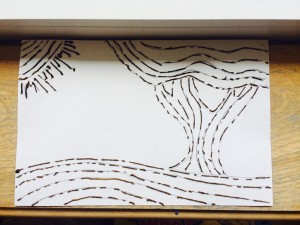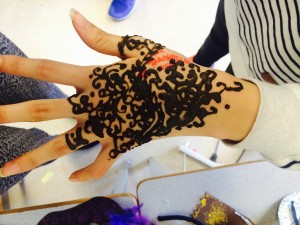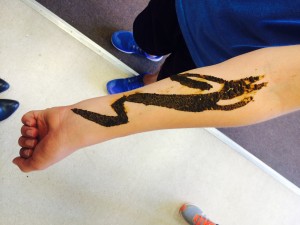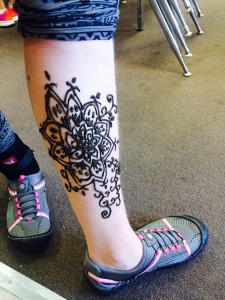
At the end of the day, we had a henna lesson. We started with a discussion of henna and the importance it has in the Indian culture. Students knew a lot about it and we related it to modern day culture. For example, we talked about henna parties in Indian weddings and the students connected this to bachelorette parties from Western culture – something I did not think of myself! I also had my friend who is very familiar with henna application come in and help the students and they were really excited to see a new face in the classroom. I had thought I would have to work with the boys much more than I had to. They were actually doing fine on their own. I think this was probably because I left the assignment quite open-ended and asked them to explore with their creativity. I allowed them to use their devices to search designs and had images of henna designs on the Smart Board. I had thought some students might not want to use the henna on their body so I gave them an option of applying onto thick Bristol board. It was great fun and learning!
Category Archives: Student Work
Beginning Poetry with a Kahoot!
Today (April 30/2015) we began poetry! When I told the students we would be beginning poetry, I got the moaning and groaning that I had expected. But, I had my plan of attack. I tried to make this lesson as engaging as possible. However, I needed to keep the beginning somewhat calm, so I chose to have the students do a quick write about anything they think of when they hear poetry. They then shared their thoughts out-loud. But, I thought some students would be sort of sensitive to this as some aspects of poetry can be personal for some. So, I had to first explain that not everything has to be shared out loud, only what they are comfortable with. And to my surprise, the students had a lot of interesting stuff to share and in their quick writes. As a form of assessment for learning, this will really help me with deciding how the unit will develop in the upcoming lessons.
After this quick write, I thought I had to address the students’ fears and hesitations about poetry. I thought it was really important to emphasize the limitless nature of poetry. That is, there is no correct way of going about poetry. Coming back to the idea of always trying to give the students a purpose, I explained that this is a time they would be able to experiment with writing and language. I always think relating learning content to real-life is really important in establishing purpose. So I gave examples from my own life and understanding the position they are in, because I was in their position only ten years ago. Then they did something I had not anticipated, they calculated my age. It was a funny moment and I just took it to support my point further. That is, that I really do understand how they feel because I’ve been through it as well. I then got them to think about how we deal with our emotions – whether happy or sad – through expressing ourselves using language. This got us to talk about the importance of emotion and feelings in poetry.
This discussion was supplemented by a poetic license. I really tried to exaggerate and emphasize what happens when students get this license – almost like it was a real license. I told them they could break the rules now, that they were ready for poetry. I thought it is like a concrete piece of evidence that the students are ready to read, write, even analyze poetry. My favorite part of teaching is when the students surprise me with ideas/aspects of topics that I did not even begin to think about. For example, when we started talking about breaking the typical rules of English language and writing, the students began thinking about writing poetry on topics like food. Now, I know that food will definitely be a part of one of our poetry lessons. Then on the poetic licenses, it required students to write their names. When they came to this part, a couple of students were asking me “do we write our real name?” and I was actually a little confused. What they were trying to do was write a nickname as their poet name. I thought this was so creative, a sign of their engagement.
We then moved onto a Kahoot quiz I made about poetry terms, which really was a kahoot! I had expected the students to be pretty “hyper” about this interactive quiz. Although, I had a paper version in case, I did not need to use it. Because, I thought this is the first time we are using this program in class and they were definitely going to be excited because of the competitive nature of the quiz. However, I did need to give a few beginning instructions, like keeping their usernames appropriate, not yelling out answers and allowing enough time to get everyone connected to the program. I tried to let them just enjoy the interactive quiz. However, to make it more of a learning experience as well, I debriefed after questions I felt needed a discussion. This way students were able to explain their answers. During the quiz, the class was probably the loudest they have ever been. But they really were engaged and I would definitely use it again because even though they were loud, they were really thinking about the questions – just in a competitive manner. I ended off the quiz by explaining this is just the introduction to these terms and they got a vocabulary list they will be filling out as they learn about each.
We then moved onto the humorous poems by Ken Nesbitt. I chose these poems on purpose as well because I thought they would be a pleasant way to start off poetry and to demonstrate that poetry does not always need to be sad or serious. I was really careful with the poems I chose, trying to make them as relatable to the students’ lives as possible. And, as I receive the students’ analysis’ of the poems, a lot of their responses include how understanding these poems was easier because they poems relate to their life.
I had to change the brain break to the end because if I had done it in the middle of the lesson, it may have caused the students to become more distracted. Because of this, I had to incorporate the brain break into my closure, which ended up working really well, as the students were able to review. I also made sure to remind them about our Kahoot quiz and the ideas from our previous discussion. This was the first time I have had the students be so excited about something like the Kahoot. I could have asked them to quiet down, but then I thought what would be the point of the Kahoot if they were not excited, then it would be like any other paper quiz. So, I realized that sometimes we need to change our usual expectations of the students when we introduce new programs and ways of learning like Kahoot. Instead of looking at their behavior as negative, I saw it as very positive – a demonstration of their participation and engagement. This was a great example of how to include technology in your class to make a topic which students are hesitant about – like poetry – into something they enjoy!


